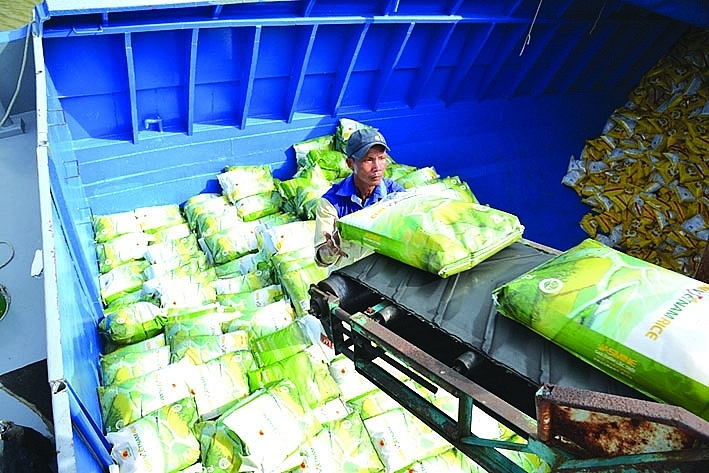Rice exports surge triumphantly
Rice exports have become a bright spot as they have achieved impressive growth amidst a deep decline in various other commodities. This positive trend is forecasted to continue as market demand remains high, coupled with efforts from businesses and localities to improve the quality and value of rice grains.
 |
|
Loc Troi Rice is heading for export to Europe. Photo: TL |
Insufficient rice for export
According to statistics from the General Department of Customs, in the first four months of 2023, Vietnam's rice exports reached 2.9 million tons, valued at 1.52 billion USD, representing a 40.7% increase in volume and a 51.6% increase in value compared to the same period in 2022. Furthermore, the announcement from the Vietnam Food Association (VFA) indicates that in the past week, the price of Vietnam's 5% broken rice for export increased by an additional 5 USD, reaching 488 USD per ton. This is the highest price recorded since the beginning of the year and 15 USD higher than the peak in February.
With the achieved results in the first four months of 2023, rice has become one of the few commodities that have maintained positive growth, while many other items have experienced a decline. According to the Ministry of Industry and Trade assessment, the rice export market has shown good growth in traditional markets, such as the Philippines, China, and potential markets, like Chile and Singapore. In particular, rice export value to the EU has recorded significant growth in many markets, thanks to the export of fragrant rice and high-quality rice with high added value. This indicates that the quality of Vietnamese rice is improving, meeting the demanding market requirements and demonstrating the potential to expand market share for high-quality rice from Vietnam.
Mr Huynh Van Khoi, Director of Dai Duong Xanh Import-Export Company, also mentioned a rice shortage for export, especially high-quality rice according to market standards. For example, the demand for high-quality rice is significant in the EU market. Previously, Dai Duong Xanh Company exported only 1-2 containers per year to the EU (about 20 tons per container), but it has increased to several thousand tons yearly. However, according to Mr Khoi, the demand in this market is still very high. "Previously, customers bought Vietnamese rice because of its low price, but now Vietnamese rice is chosen for its fragrance and quality," Mr Khoi stated.
From now until the end of the year, the outlook for rice exports is forecasted to continue favourably. According to Mr Tran Quoc Toan, Deputy Director of the Import-Export Department at the Ministry of Industry and Trade, China's announcement to reopen its market is a positive signal for rice exporters. In addition, China has also declared the official opening of the Mong Cai border gate (Quang Ninh) as a qualified entry point for grain imports into China, with a maximum quantity of 200,000 tons per year. Therefore, together with the Huu Nghi border gate (Lang Son), Vietnam now has two land border gates allowing to import of grains into Guangxi (China).
Data from the Chinese Customs Agency shows that in the first two months of this year, while China reduced its rice imports from India, Pakistan, and Thailand, it significantly increased imports from Vietnam. As a result, Vietnam's market share in China's total rice imports rose 19.2% compared to 6.7% in 2022.
Continuing to improve quality and value.
In light of the positive signals from the global rice market, localities and businesses are focusing on replanning cultivation areas and expanding the cultivation of high-quality rice. Mr Huynh Van Khoi emphasizes the need to replan cultivation areas to increase the supply of high-quality rice and build a brand for Vietnamese rice.
At the local level, Mr Nguyen Huu Dung, Director of the Department of Industry and Trade in Dong Thap province, stated that in 2022, the entire province had 64,300 hectares of rice production under cooperative links, with a total output of 434,000 tons, accounting for 17% of the total rice production area. In addition, 43 cooperatives, 22 cooperative groups, and farmers signed contracts with 38 domestic and foreign companies to establish cooperative links. However, Mr Dung assessed that the level of cooperation is still modest compared to the province's area and production output. Therefore, in the coming time, Dong Thap will focus on enhancing cooperation, promoting high-quality rice production, ensuring food safety, increasing productivity, and reducing costs to bring higher profits to farmers and stabilize exports.
Mr Pham Thai Binh, CEO of Trung An High-Tech Agriculture Joint Stock Company, also affirmed that the rice market is not a cause for concern because, regardless of the fluctuations in the world, there is always demand for rice. The current task is to strengthen cooperation to improve the quality and value of rice grains. Vietnam has not fully utilized its advantages for a long time, so rice has been sold at low prices. Currently, many businesses are eagerly looking for cooperative fields to participate in. When businesses and farmers collaborate, the quality and value of Vietnamese rice will undoubtedly be enhanced.
To better exploit markets in the future, Mr Nguyen Thanh Huan, Deputy Director of the Department of Industry and Trade in An Giang province, believes that localities and businesses should use Vietnam's trade missions abroad. According to Mr Huan, An Giang's rice exports have achieved very positive results recently, partly due to the support of the trade mission system. "When localities exchange information, trade missions provide enthusiastic support. Thanks to that, An Giang has connected businesses with trade missions to access markets. The trade missions also suggest that localities provide sample products and information about the products to introduce to businesses in their respective countries," shared Mr Huan. As a result, in addition to traditional markets in Asia, An Giang has successfully exported rice to Russia and Bangladesh. Especially, Loc Troi Group has exported about 1,000 tons to the European market.








